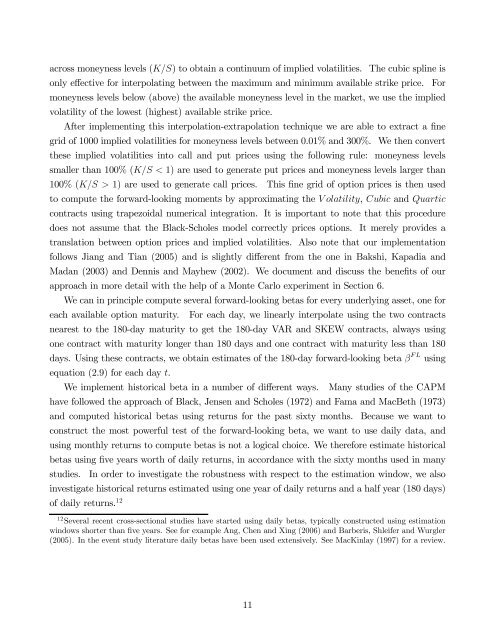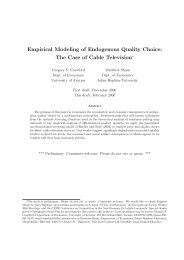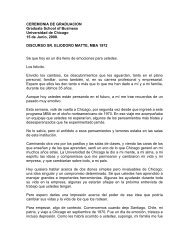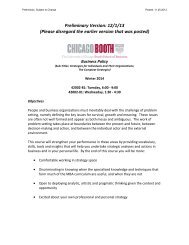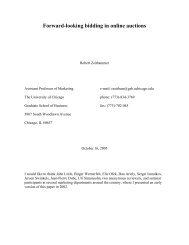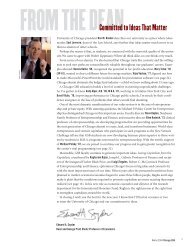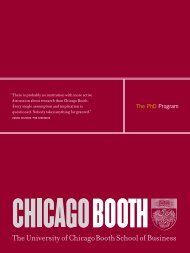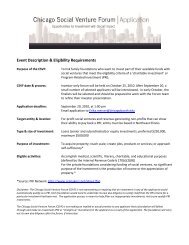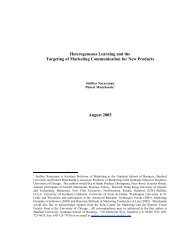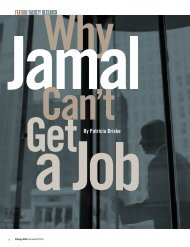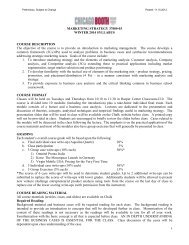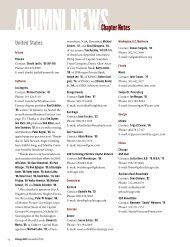Forward-Looking Betas - The University of Chicago Booth School of ...
Forward-Looking Betas - The University of Chicago Booth School of ...
Forward-Looking Betas - The University of Chicago Booth School of ...
You also want an ePaper? Increase the reach of your titles
YUMPU automatically turns print PDFs into web optimized ePapers that Google loves.
across moneyness levels (K/S) to obtain a continuum <strong>of</strong> implied volatilities. <strong>The</strong> cubic spline isonly effective for interpolating between the maximum and minimum available strike price. Formoneyness levels below (above) the available moneyness level in the market, we use the impliedvolatility <strong>of</strong> the lowest (highest) available strike price.After implementing this interpolation-extrapolation technique we are able to extract a finegrid <strong>of</strong> 1000 implied volatilities for moneyness levels between 0.01% and 300%. We then convertthese implied volatilities into call and put prices using the following rule: moneyness levelssmaller than 100% (K/S < 1) are used to generate put prices and moneyness levels larger than100% (K/S > 1) are used to generate call prices. This fine grid <strong>of</strong> option prices is then usedto compute the forward-looking moments by approximating the Volatility, Cubic and Quarticcontracts using trapezoidal numerical integration. It is important to note that this proceduredoes not assume that the Black-Scholes model correctly prices options. It merely provides atranslation between option prices and implied volatilities. Also note that our implementationfollows Jiang and Tian (2005) and is slightly different from the one in Bakshi, Kapadia andMadan (2003) and Dennis and Mayhew (2002). We document and discuss the benefits <strong>of</strong> ourapproach in more detail with the help <strong>of</strong> a Monte Carlo experiment in Section 6.We can in principle compute several forward-looking betas for every underlying asset, one foreach available option maturity. For each day, we linearly interpolate using the two contractsnearest to the 180-day maturity to get the 180-day VAR and SKEW contracts, always usingone contract with maturity longer than 180 days and one contract with maturity less than 180days. Using these contracts, we obtain estimates <strong>of</strong> the 180-day forward-looking beta β FL usingequation (2.9) for each day t.We implement historical beta in a number <strong>of</strong> different ways. Many studies <strong>of</strong> the CAPMhave followed the approach <strong>of</strong> Black, Jensen and Scholes (1972) and Fama and MacBeth (1973)and computed historical betas using returns for the past sixty months. Because we want toconstruct the most powerful test <strong>of</strong> the forward-looking beta, we want to use daily data, andusing monthly returns to compute betas is not a logical choice. We therefore estimate historicalbetas using five years worth <strong>of</strong> daily returns, in accordance with the sixty months used in manystudies. In order to investigate the robustness with respect to the estimation window, we alsoinvestigate historical returns estimated using one year <strong>of</strong> daily returns and a half year (180 days)<strong>of</strong> daily returns. 1212 Several recent cross-sectional studies have started using daily betas, typically constructed using estimationwindows shorter than five years. See for example Ang, Chen and Xing (2006) and Barberis, Shleifer and Wurgler(2005). In the event study literature daily betas have been used extensively. See MacKinlay (1997) for a review.11


